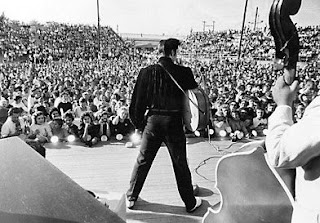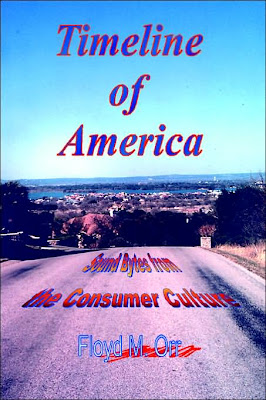
I originally published the following list of Americana at Authors Den on February 17, 2005. I intended it to be an introduction to what I thought at the time would become a matched set of books entitled Timeline of America: Sound Bytes from the Consumer Culture and 2010: Timeline for a Psychotic Nation. The former book would compile a list of the most entertaining consumer issues developed throughout the history of the nation. The latter would show how these same issues developed into a monster that would devour the same nation.
The article you see here drew a lot of attention at Authors Den, but I have always felt that this occurred for the wrong reason. I think it was because most potential readers who saw the title thought it was a treatise on the failings of The Bush Administration. These were the things most Americans were focused on back in 2005. There was nothing wrong with that negative attention toward The White House at that time. Bush is no doubt a horse's butt of sorts and he most certainly took us into a needless, and ultimately very destructive, war. I have always been ahead of the curve. That's what inspires me to write in the first place. My intent was to show the future of America, not the present. The economic debacle we are experiencing now has been obvious to some of us for a very long time, and that is what this story is really about. As long as many people were getting rich, we didn't care that we were building a house of straw instead of bricks. Now in 2008 we suddenly care. I pray it's not too late for us all.
I call this little list an example of Accelerating into Madness. The following dates are not to be taken too seriously. The specific year may be off by a digit or two, but if it is, get a grip. This is not the American Hysterical Society. It's just me, representing the Baby Boomer Generation and the self-appointed psychoanalyst of a paranoid schizophrenic nation. References to particular corporate entities were sourced directly from the companies' own websites. Bring on the sacred cows....
1692 - The Salem Witch Trials
1773 - The year we threw the tea in the lake
1776 - The nation was officially founded
1861 - The Civil War begins
1865 - The Civil War ends and the slaves begin a long journey into freedom
1886 - Coca-Cola invented by an Atlanta druggist
1896 - First full-size, comprehensive Sears & Roebuck catalog
1925 - First Sears retail store opens in Chicago
1927 - The birth of the Craftsman and Kenmore brands
1928 - The last year that cocaine was an ingredient in Coca-Cola
1929 - The Stock Market Crash sets off The Great Depression of the '30's
1940 - The first McDonald's opens
1945 - Sears exceeds $1 billion in sales
1948 - World War II is over and the Baby Boomers have already begun
1950 - The beginning of the ultra-conservative '50's - The "I Like Ike" years continue
1953 - The Corvette and Playboy Magazine are launched
1954 - Brown v. Board of Education
1955 - The T-bird takes flight, Chevy and Ford both introduce small-block V-8's, and Elvis gets famous for swiveling hips and a quivering lip - Disneyland opens
1956 - Elvis performs his last small-town concert in Tupelo, MS
1957 - Car tailfins expand and proliferate - fuel injection makes its appearance
1958 - The T-bird becomes the first "Personal Luxury Car"
1959 - The first Honda motorcycles come to America - 100 McDonald's nationwide
1960 - Sony brings the transistor radio to America
1961 - The lunch counter sit-in by four black students in Greensboro, NC
1962 - The first Wal-Mart opens in Rogers, AR (home of Daisy BB guns) - James Meredith enrolls at Ole Miss
1963 - The Beatles appear on The Jack Paar Show via videotape - "The Times They Are A'Changin" - The Corvette Sting Ray and the last model of Studebaker, The Avanti, appear - the one-billionth McDonald's hamburger sold - 500 McDonald's nationwide - Ronald McDonald appears - the assassinations begin with JFK
1964 - The Civil Rights Act - The Beatles come to America - Mustang & GTO arrive - the most famous Civil Rights slaying by the KKK in Neshoba County, MS
1965 - Vietnam - The Sexual Revolution - musclecars - "Like a Rolling Stone" - Honda brings its first car to California, The S-600 Convertible
1966 - Six Flags Over Texas opens - Revolver (Yes, Maybelle, The Beatles do smoke pot.) - John Lennon quotes "We're more popular than Jesus now."
1967 - Jimi Hendrix - Cream - Jefferson Airplane - Haight-Ashbury - Monterey Pop - Sgt. Pepper
1968 - Electric Ladyland - Wheels of Fire - Stingray - Toyota Corona distributed nationwide - the first Big Mac - 1000 McDonald's - The Graduate hears about plastics - 2001: A Space Odyssey
1969 - the peak of America's best days
1970 - You can never go home again - the beginning of the end - Ross Perot introduces his town meeting concept on national television
1971 - The Egg McMuffin test marketed
1972 - 2000 McDonald's
1973 - The Oil Embargo - Six Flags starts a trend with the first of the new generation of supercoasters at its Atlanta park, The Great American Scream Machine - Egg McMuffin officially introduced
1974 - 3000 McDonald's
1975 - The Wal-Mart Cheer introduced to employees by Sam Walton - first McDonald's Drive-Thru opens in Arizona
1976 - Watergate - Did we learn anything from it? - Honda Accord introduced - Cadillac swears that it is building its last convertible - 4000 McDonald's
1977 - Star Wars is born - The King is Dead
1979 - First Home Depot opens in Atlanta
1980 - Let's elect an actor President. Yeah, that's the ticket (to our insanity)! - John Lennon assassinated - 6000 McDonald's
1982 - 7000 McDonald's
1983 - The first Sam's Club opens in Midwest City, OK - Chicken McNuggets
1984 - 50 billionth hamburger sold - 17 million customers daily - 22 people shot in McDonald's in San Diego - Apple Macintosh introduced during the Superbowl
1985 - First Dell computer - Microsoft Windows introduced - Sears introduces Discover card
1986 - Sixty Home Depot stores
1987 - The next big stock market crash - 20 million McDonald's customers daily
1988 - Bush, Sr., continues the downhill slide of the American economy - the first Wal-Mart Supercenter opens in Washington, MO
1989 - Fox Network premiers the first reality TV show, Cops
1990 - Wal-Mart becomes the nation's #1 retailer
1991 - 174 Home Depot stores
1992 - The death of Bill Hicks, the most poignant comic of the '80's era - Bush Sr. gives Sam Walton the Medal of Freedom
1993 - Wal-Mart has its first $1 billion sales week
1994 - 15,000 McDonald's
1995 - 423 Home Depot stores
1996 - $200 million McDonald's marketing blitz
1997 - Wal-Mart becomes the #1 employer in the U.S. - annual sales of $105 billion
1998 - 761 Home Depot stores
1999 - The biggest stock market bubble in our nation's history - Wal-Mart becomes the largest private employer in the world
2000 - The tech bubble pops - 1123 Home Depot stores
2001 - The airline industry crashes and the Dow falls on its face - Enron - Worldcom - Wal-mart sells $1.25 billion on the day after Thanksgiving
2002 - Bush starts a war just to please his oil company cronies - Fortune Magazine ranks Wal-Mart as the #1 "Most Admired Company in America" - 1532 Home Depot stores
2003 - The national deficit sets new records - Fortune Magazine ranks Wal-Mart #1 again - Cedar Point features 16 roller coasters
2004 - Karl Rove comes to power to destroy America through his puppet, Dubya - Wal-Mart has 1625 Supercenters and employs 1.2 million in the U.S. alone - FCC slaps Fox Network with $1 million indecency fine, the largest in history - 23 Six Flags theme parks in the U.S.
2005 - KKK member / Baptist preacher Edgar Ray Killen arraigned in Philadelphia MS for the murder of the three Civil Rights workers in 1964 - 1800 Home Depot stores - a new Home Depot store opens every 48 hours - Hurricane Katrina destroys New Orleans and Dubya still doesn't want to discuss global warming. Hurricane Rita forces the evacuation of Houston only three weeks later - and he still doesn't want to talk about it!
2006 - What disaster will top Katrina?
2007 - Subprime greed pops the housing bubble.
2008 - The financial services house of cards finally comes crashing down!
2009 - The lame duck limps out of The White House and a decent President takes his place.
2010 - It's all over but the crying. America is an all-new world....































